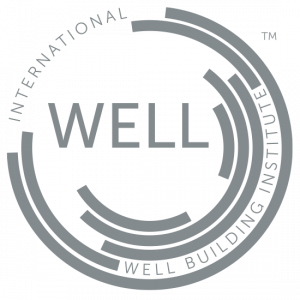The WELL Building Standard focuses on improving the health and well-being of building occupants. It evaluates various aspects of a building’s design, construction, and operations that impact human health, such as air quality, lighting, water quality, and ergonomic features. Achieving WELL certification signifies a commitment to creating a healthy and productive indoor environment. Developed by the International WELL Building Institute (IWBI).
Categories:
- The WELL Standard encompasses seven primary categories: air, water, nourishment, light, fitness, comfort, and mind.
- Each category has specific features and criteria aimed at promoting occupant well-being.
Certification Levels:
- WELL certification is achieved through earning points in each of the seven categories.
- Certification levels include Silver, Gold, and Platinum, depending on the total points earned.
Applicability:
- The WELL Standard can be applied to various building types, including commercial, residential, and institutional.
- It can be used for both new construction and existing buildings through WELL Core and Shell, WELL Interior, and WELL Operations and Maintenance.
Assessment Process:
- Projects undergo a performance-based assessment process, including documentation review and onsite performance testing.
- Certified professionals called WELL APs (Accredited Professionals) guide and assess projects.
Categories' Focus:
- Air: Emphasises indoor air quality, ventilation, and control of pollutants.
- Water: Promotes access to clean and safe drinking water and encourages water conservation.
- Nourishment: Encourages healthy eating options, such as access to fresh fruits and vegetables.
- Light: Focuses on optimising natural and artificial lighting to enhance circadian rhythms and reduce glare.
- Fitness: Promotes physical activity through design features and opportunities for exercise.
- Comfort: Enhances occupant comfort through factors like thermal control and ergonomics.
- Mind: Addresses mental health and well-being, including stress reduction and biophilic design.
Benefits:
- WELL-certified buildings are designed to improve occupant health, productivity, and well-being.
- Benefits include reduced absenteeism, enhanced focus, and improved overall quality of life.
- Attractive to employers and organisations seeking to promote employee wellness.
Continuous Improvement:
- The WELL Standard is periodically updated to incorporate new research and best practices in health and wellness design
Global Reach:
- While originating in the United States, the WELL Standard has gained international recognition and can be applied globally.
Sustainability Goals:
- WELL supports broader sustainability goals by addressing human-centric aspects of building design, operation, and management.
Certification Process
To achieve certification, projects must undergo a third-party assessment by WELL assessors and meet specific performance requirements.

